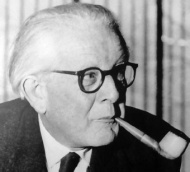Jean Piaget
From Geography
The from origin Psychologist Jean Piaget was born in 1896 in Switzerland. Although he studied biology he became interested in philosophy and epistemology (where does knowledge come from and what do we know?). Thereupon Piaget became famous with the concepts about the through him related terms learning and structuralism.
Especially Piagets theory of cognitive psychological development of children, was not only biologically and pshycologically interesting, it became also an important part of structuralism.
Piagets opinion was that the process of gathering knowledge consists of different phases (or stages), and therefor structures. Each stage in the development of knowledge has its own characteristics, systems and possibilities. So Piaget formulated four different learning stages in the development of children.
But also knowledge itself consists of structures, according to Piaget. And to gain knowledge in life, there are 3 mechanics. These are assimilation, accomodation and equilibration.
- Assimiliation is the ability to see an environment in relation to structures you made in your life. For example, you call a place a city according to your structures and knowledge about cities you already have. At that moment, you rely on your imagination (created through structures) about cities you have been build in your life.
- Second, accomodation is about the change of a structure in your imagination as a consequence of assimilation. In other words: every day the structures about all kind of things in your environment are changing through assimilation. For example, your idea of a city changes because of your observation during assimilation.
- But you can imagine that life would become very uncertain, chaotic, restless and changeable, when ideas and structures are formed or build up and immediately change because of assimiliation and accommodation. So a reasonable and healthy midway between these two concepts is called equilibration.
Through concepts and mechanics as assimilation and accomodation the structures in life are becoming more complex, while learning (Vervaet, 1990).
Example
These concepts are important for map reading. Since the map provides the basic tool for reporting spatial interactions, the ability to read maps meaningfully is a primary objective of instruction. Map reading, in contrast, requires the reader to develop meanings for a wide variety of symbols, some conventional print but others of varying degrees of abstraction, all arranged through conceived space in a relational two-dimensional environment (US state university, 2007). So the structures people built in their lives are important to understand as well as create different forms of maps.
References
- US State University (2007). Teaching of Geography - Effectiveness of Instruction, Maps and Spatial Concepts, Evaluating Geographic Learning.
- Vervaet, E. (1990). Genetische epistemologie. Struktuur en genese, 1990, vol.3, p.3-29.
- Van der Wal, J., de Mooij, I., de Wilde, J. (2006). Identiteitsontwikkeling en leerlingbegeleiding (3e herziende druk). Bussum: Coutinho Pagina: 137-140
Contributors
- Published by Luuk Robers & Paul Leemans
- Page enhanced by Iris van der Wal - 17:37, October 19th 2012
- Page added to the category Post-structuralism by Marleen Revenberg, 23 October 2012
- Picture added by Doris Roelvink, October 25th 2012
